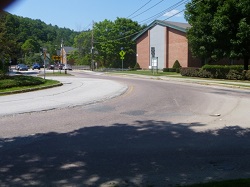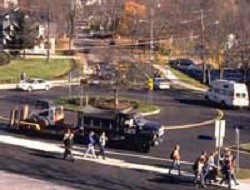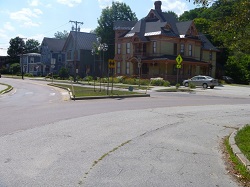Main Street Roundabout
Montpelier, Vermont
Prepared by Laurie Actman, Patrick McMahon, and Henry Renski, University of North Carolina Highway Safety Research Center, and Thomas J. McArdle, Montpelier, Vermont Department of Public Works.
Montpelier, Vermont
Prepared by Laurie Actman, Patrick McMahon, and Henry Renski, University of North Carolina Highway Safety Research Center, and Thomas J. McArdle, Montpelier, Vermont Department of Public Works.
An intersection in Montpelier, Vermont had a confusing traffic pattern and lacked a pedestrian crosswalk for one of the streets. A group advocating the benefits of roundabout design asked the City to do a roundabout demonstration project.

In the early 1990s, the Montpelier City Council was approached by a locally stationed state transportation planner and some local residents who wished to find a location to do a roundabout demonstration project. In response to this request, the City Council organized a roundabout steering committee to determine a location to test this intervention.
The group initially considered a signalized intersection under construction for the roundabout, but a demonstration project using lumber and pavement markings revealed numerous geometric and utility relocation issues at the site. The roundabout steering committee had to consider other intersections.
The unsignalized intersection of Main and Spring Streets was another option because it was on the construction consideration list, but it was a low priority. Although, vehicle flow at the intersection functioned within reasonable levels, the intersection had a confusing traffic pattern and lacked adequate pedestrian accommodations. No crosswalk was provided for pedestrians to cross Spring Street. The committee selected this location for the demonstration project and successfully lobbied the City Council for funds based on their own cost estimate.

Overall, the roundabout improved conditions for both pedestrians and vehicles at the intersection of Main Street and Spring Street.
After working with the roundabout steering committee, a roundabout was installed in August of 1995. It consisted of a single roundabout with a radius ranging from 52.7 ft to 54.2 ft, three single lane approaches, a commercial driveway, and a single circulating lane. The roundabout has a wide asphalt apron to accommodate the roughly 40 heavy trucks passing through the intersection on weekdays, a landscaped center with a tree, and a granite curb. Splitter/deflector islands on the branches are intended to force vehicular traffic to enter the roundabout using only right turns. The approaches were designed to slow vehicular traffic to yield to pedestrians in the crosswalks. The crosswalks are painted 20 ft back from the yield line and cross through the splitter islands at all three approaches.

The roundabout was installed using entirely local funding. Construction of the roundabout, originally estimated by the roundabout steering committee to cost $62,000, had a final cost totaling $160,000. The committee's original estimate was low because drainage systems had to be relocated and the City had to purchase property to fit the circular roundabout where the "T" intersection was located.
At first, some residents did not like the roundabout because of its cost and the fact that it was a "project looking for a place to happen." Further, some truck drivers avoid it because of its restrictive approaches and its abrupt edges of granite curb, and some elderly drivers have complained that they were intimidated by the yield rules. Some automobile tires were damaged when drivers cut too close to the granite edge of the roundabout or passed through at speeds higher than intended. After completion of the project, citizens suggested installing signs that require lower speeds within the roundabout and providing more effective landscaping to the apron to clarify the roundabout's size.
The roundabout had benefits for motorists and pedestrians alike. For motorists, the roundabout works better for vehicular traffic than a signalized intersection. All three approaches to the intersection have a posted speed limit of 25 mi/h (40 km/h), and actual speeds may be even slower because of the approach and departure geometry of the roundabout. While most area drivers still use the same routes (the average daily traffic levels continue to be about 5,000 vehicles/day on Main Street south of the roundabout, 2,500 vehicles/day on Main Street north of the roundabout, and 6,000 vehicles/day on Spring Street), the median peak hour delay reduced from 11.6 s to 2.2 s and average peak hour delay dropped from 6.3 s to 2.7 s at the intersection. Also, the roundabout was one of the only design alternatives for the intersection that could accommodate a commercial driveway without creating inconvenient turning restrictions. A number of vehicles have been observed making "U-turns" around the roundabout and obeying the no U-turn sign on Main Street itself. When an adjacent street, Elm, was temporarily closed due to a rockslide, the roundabout effectively absorbed the resulting higher traffic volumes.
The roundabout offers an improved pedestrian safety environment at the intersection, especially students and staff who walk to nearby Main Street Middle School. While the "T" intersection created conflicts between fast-moving vehicles and pedestrians using the intersection to go to school, the roundabout improved safety for the students and staff by requiring vehicles to decrease speed within the roundabout and to enter Main Street at slower speeds. In addition, the pedestrians used the new marked crosswalks to cross the approaches to the roundabout.
In spite of initial reactions, the overall reaction to the roundabout has been positive. In a follow-up survey conducted one year after the project's completion, 85 percent of the respondents had a favorable or neutral opinion of the roundabout. According to Assistant Principal Tom Lever, the pedestrian crossings at the roundabout are significantly safer for his students. Because the roundabout is built to prevent drivers from speeding through the intersection, they are better prepared to yield at the pedestrian crossing. He also estimated that this intersection, previously avoided by most pedestrians, now has 30 to 50 students walking through the roundabout in the morning and roughly 150 walking through in the afternoon.
In 2009, Main Street Middle School applied for federal grant money for pedestrian safety improvements through the Safe Routes to School program. The school used the $110,000 in funds they received to install curb extensions/bulb-outs and improved crosswalks in the vicinity of the school. The only recommended change to the roundabout was the relocation of a school advance warning sign to a more visible location and the upgrade of its flashing beacon to solar-powered LEDs.
Thomas J. McArdle, Assistant Director
Montpelier Department of Public Works
39 Main Street -- City Hall
Montpelier, VT 05602
Phone: (802) 223-9508
Fax: (802) 223-9508
Email: tmcardle@montpelier-vt.org
For more information on Main Street Middle School's Safe Routes to School program, see http://www.saferoutesinfo.org/data-central/success-stories/montpelier-vermont-new-way-go
The Montpelier, Vermont Public Works Department website: http://www.montpelier-vt.org/department/14/Public-Works.html